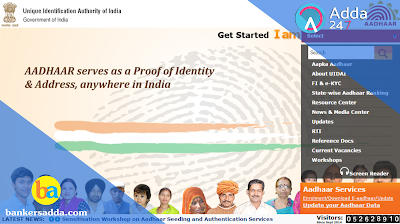Dear Readers,
Currently, UIDAI has been in the news as the Centre has made it mandatory to quote the Aadhaar number for opening bank accounts and for transactions exceeding Rs.50,000. Now as we have seen in many past exams that always there were some questions asked from UIDAI so, we Adda247 provides you short notes on UIDAI which will help you in upcoming banking exams.
What is UIDAI?
The Unique Identification Authority of India (UIDAI) is a statutory authority established under the provisions of the Aadhaar (Targeted Delivery of Financial and Other Subsidies, Benefits and Services) Act, 2016 (“Aadhaar Act 2016”) on 12 July 2016 by the Government of India, under the Ministry of Electronics and Information Technology (MeitY).
Prior to its establishment as a statutory authority, UIDAI was functioning as an attached office of the then Planning Commission (now NITI Aayog). Later, on 12 September 2015, the Government revised the Allocation of Business Rules to attach the UIDAI to the Department of Electronics & Information Technology (DeitY) of the then Ministry of Communications and Information Technology.
UIDAI was created with the objective to issue Unique Identification numbers (UID), named as “Aadhaar”, to all residents of India that is-
(a) robust enough to eliminate duplicate and fake identities, and
(b) can be verified and authenticated in an easy, cost-effective way.
The first UID number was issued on 29th September 2010 to a resident of Nandurbar, Maharashtra. The Authority has so far issued more than 111 crore Aadhaar numbers to the residents of India.
Aadhaar Act 2016,
Under the Aadhaar Act 2016, UIDAI is responsible for Aadhaar enrolment and authentication, including operation and management of all stages of Aadhaar life cycle, developing the policy, procedure and system for issuing Aadhaar numbers to individuals and perform authentication and also required to ensure the security of identity information and authentication records of individuals.
Organizational Structure
Unique Identification Authority of India (“Authority/UIDAI”) has its Headquarters (HQ) in New Delhi and eight Regional Offices (ROs) across the country. UIDAI has two Data Centres, one at Hebbal (Bengaluru), Karnataka and another at Manesar (Gurugram), Haryana
Composition of UIDAI Authority-
The Authority consists of a Chairperson appointed on part-time basis, two part-time Members and a Chief Executive Officer who shall be the Member-Secretary of the Authority.
1. Shri J Satyanarayana (Chairman (part-time), UIDAI)
Shri J Satyanarayana, IAS retd. (1977, AP cadre) is the part-time Chairman of the Unique Identification Authority of India (UIDAI).
2. Shri Rajesh Jain (Member (part-time), UIDAI)
Shri Rajesh Jain is appointed as part-time member of the Unique Identification Authority of India (UIDAI).
3. Dr. Anand Deshpande (Member (part-time), UIDAI)
Dr. Anand Deshpande, is appointed as part-time member of the Unique Identification Authority of India (UIDAI).
4. Dr. Ajay Bhushan Pandey (Chief Executive Officer (CEO), UIDAI)
Dr. Ajay Bhushan Pandey is the Chief Executive Officer(CEO) of Unique Identification Authority of India UIDAI and has been steering Aadhaar in India since its beginning in 2010.
Features of Aadhaar:-
1. Uniqueness
2. Portability
3. Random Number
4. Scalable Technology Architecture
5. Open Source Technologies
Aadhaar A Must For Bank Accounts: facts to keep in mind-
1. The last date to furnish Aadhaar number issued by the Unique Identification Authority of India (UIDAI) is December 31, 2017, failing which the bank account will become non-functional.
2. Aadhaar details are also mandatory for opening of new bank accounts.
3. From June 1, 2017, citizens unable to provide Aadhaar number at the time of account opening will have to provide Aadhaar enrolment number. The Aadhaar number will then need to be provided to bank within six months of opening of the bank account.
4. The notification issued by revenue department also mandates the quoting of Aadhaar, popularly called “Aadhaar card”, for any transaction of Rs. 50,000 or above.
5. Going forward, small banks’ accounts, with a maximum deposit of Rs. 50,000, can be opened only at branches with core banking solution.
6. Small deposit bank accounts can also be opened at a branch where it is possible to manually monitor and ensure that foreign remittance are not credited to such account and stipulated limits on monthly and annual aggregate of transactions and balance are not breached.
7. The new rule also applies to companies and partnership firms. They need to quote Aadhaar number along with PAN or Form 60 for all financial transactions of Rs. 50,000 or above with effect from June 1.
8. The move is aimed at keeping a check on small accounts. Currently, accounts can be opened without having valid KYC or Know Your Customer documents for a maximum deposit of Rs. 50,000.
9. The move to link all existing bank accounts with Aadhaar number comes days after the Supreme Court of India upheld an I-T Act provision that makes Aadhaar compulsory for allotment of PAN cards and for filing Income Tax returns.
Tagline of Aadhaar- Mera Aadhaar, Meri Pehchan
Earlier its tagline was “Aam Aadmi ka Adhikar” but now it has been changed to “Mera Aadhaar, Meri Pehchan”.
You may also like to read:






